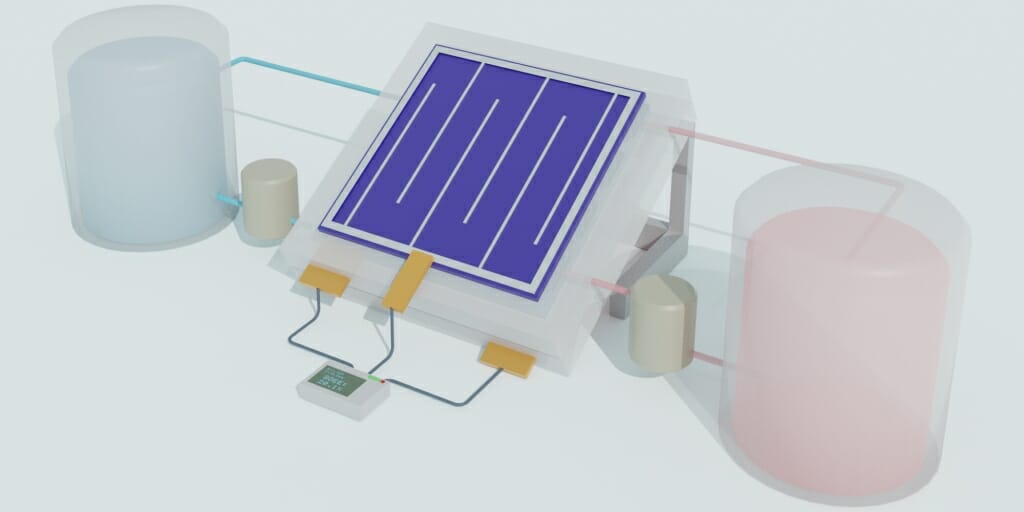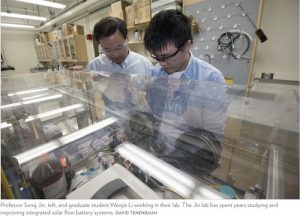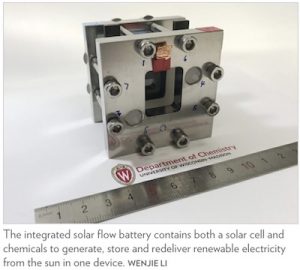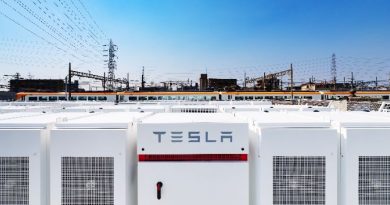Long Lasting Solar Storage Possible With Solar Flow Battery
 Schematic illustration of an integrated solar flow battery. A solar cell is hooked up to tanks of chemicals that can store electricity for later use. WENJIE LI
Schematic illustration of an integrated solar flow battery. A solar cell is hooked up to tanks of chemicals that can store electricity for later use. WENJIE LI
Chemists at the University of Wisconsin–Madison and their collaborators have created a highly efficient and long-lasting solar flow battery, a way to generate, store and redeliver renewable electricity from the sun in one device.
The new device is made of silicon solar cells combined with advanced solar materials integrated with optimally designed chemical components. The solar flow battery, made by the Song Jin lab in the UW–Madison chemistry department, achieved a new record efficiency of 20 percent. A number that bests most commercially available silicon solar cells used today and is almost 40 percent more efficient than the previous record holder for solar flow batteries, which coincidentally was also developed by the Jin lab.
While solar flow batteries are years away from commercialization, they offer the potential to provide reliable electricity generation and storage for lighting, cell phones or other fundamental uses for homes in remote areas. According to the team, these batteries combine the advantages of photovoltaic cells that convert sunlight into electricity with the advantages of flow batteries, which use tanks of chemicals that can react to produce electricity and be recharged by the solar cells.

The researchers published their work on July 13, 2020, in the journal Nature Materials. UW–Madison graduate student Wenjie Li is the lead author of the study. The Jin lab collaborated with researchers from the University of New South Wales and the University of Sydney in Australia, Utah State University, King Abdullah University of Science and Technology in Saudi Arabia and the City University of Hong Kong.
The team argues that since the sun doesn’t always shine, storage is key for practical solar electricity, especially in remote and rural regions with a lot of sunlight, such as in the sunbelt regions of the US, Australia, Saudi Arabia and Africa. Many solar home systems use lead-acid or lithium-ion batteries for electricity storage. Flow batteries, which use large tanks of liquid chemicals to store energy, could be less expensive at a larger scale and are an ideal storage choice for merging with solar cells.
The Jin lab has spent years studying and improving integrated solar flow battery systems. In 2018, it developed a solar flow battery using a triple layer of efficient but expensive solar materials that achieved an overall efficiency of 14 percent. However, corrosion greatly reduced the device’s lifetime.
In their latest report, the researchers turned to an increasingly popular material for photovoltaic cells, halide perovskites. The solar conversion efficiency of these special materials has dramatically increased from a few percents to over 25 percent in 10 years. Recent research has shown that halide perovskites can also increase the efficiency of traditional silicon solar cells by capturing more energy from the sun.

To predict the ideal voltage that the flow batteries should run at, Li developed a new theoretical modeling method. The modeling allowed him to select a pair of chemicals in the flow battery that would operate at the ideal voltage based on the characteristics of the solar cell, maximising efficiency. The chemicals are organic compounds, not expensive metals as in traditional flow batteries, and are dissolved in a benign water solution of table salt rather than strong acids.
“Our eventual goal, if we can make this practical, is to target solar home systems,” said Li. “People who don’t have electrical grid access could use this device to have reliable electricity.”
For more details on the findings of the report click here.
Source: saurenergy.com




